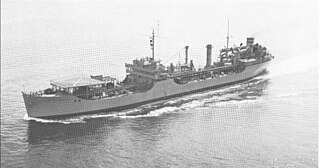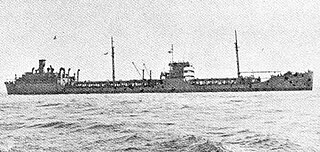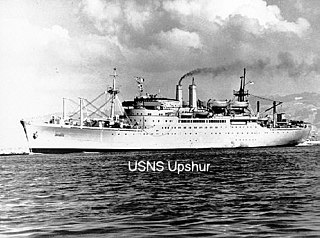
The National Defense Reserve Fleet (NDRF) consists of "mothballed" ships, mostly merchant vessels, that can be activated within 20 to 120 days to provide shipping for the United States of America during national emergencies, either military or non-military, such as commercial shipping crises.
The Beaumont Reserve Fleet, was established by act of Congress in 1946, as a component of the National Defense Reserve Fleet (NDRF). The fleet is located in Beaumont, Texas.

ING 4727 was a barge belonging to Ingram Barge Company that became infamous when it went over or through a levee and landed in a residential neighborhood of New Orleans, Louisiana during Hurricane Katrina.

USNS Sirius was a Sirius-class combat stores ship of the United States Navy, named for Sirius , the brightest visible star.

SS Mission Capistrano was a Type T2-SE-A2 tanker built for the United States Maritime Commission during World War II. After the war she was acquired by the United States Navy as USS Mission Capistrano (AO-112). Later the tanker transferred to the Military Sea Transportation Service as USNS Mission Capistrano (T-AO-112). She was a Mission Buenaventura-class oiler and was named for San Juan Capistrano in San Juan Capistrano, California.

SS Mission Santa Ynez was a Type T2-SE-A2 tanker built for the United States Maritime Commission during World War II. After the war she was acquired by the United States Navy as USS Mission Santa Ynez (AO-134). Later the tanker transferred to the Military Sea Transportation Service as USNS Mission Santa Ynez (T-AO-134). A Mission Buenaventura-class oiler, she was named for Mission Santa Inés located in Solvang, California.
SS Mission San Antonio was a Type T2-SE-A2 tanker built for the United States Maritime Commission during World War II. After the war she was acquired by the United States Navy as USS Mission San Antonio (AO-119). Later the tanker transferred to the Military Sea Transportation Service as USNS Mission San Antonio (T-AO-119). She was a Mission Buenaventura-class oiler and was named for Mission San Antonio de Padua located near Jolon, California.
SS Mission San Luis Rey was a Type T2-SE-A2 tanker built for the United States Maritime Commission during World War II. After the war she was acquired by the United States Navy as USS Mission San Luis Rey (AO-128). Later the tanker transferred to the Military Sea Transportation Service as USNS Mission San Luis Rey (T-AO-128). She was a Mission Buenaventura-class oiler and was named for Mission San Luis Rey de Francia, located in Oceanside, California.

USS Soubarissen (AO-93) was an Escambia-class fleet oiler converted to a water tanker, named for a chief of the "Neutral" Indian Nations which, although a part of the Iroquois confederation, were called "neutral" by the French because they took no part in the wars of the Iroquois and Hurons. The area he governed included the oil fields of northwestern Pennsylvania and western New York. The knowledge of the oil seepages there was well known among the Indians, and it was declared neutral ground so all Indians could obtain oil for medicinal and domestic purposes without danger or interference. In 1627, Joseph de La Roche Daillon heard of the oil springs and made an expedition to visit them. He was kindly received by Chief Soubarissen, shown the oil seepages, and duly reported his observations to his superiors. These observations contributed largely to the interest in the petroleum resources of the Pennsylvania region.
USNS Bowditch (T-AGS-21) was the lead ship of her class of oceanographic survey ships for the United States Navy. Launched as the SS South Bend Victory in 1945, Maritime Commission hull number MCV 694, a type VC2-S-AP3 Victory ship, she was named for Nathaniel Bowditch, the second U.S. Navy vessel named in his honor. The ship was acquired by the Navy in August 1957 and converted to an AGS at Charleston Naval Shipyard. Named Bowditch on 8 August 1957 and placed in service 8 October 1958 for operation by the Military Sea Transportation Service (MSTS).
USTS Empire State VI (T-AP-1001), callsign KKFW, IMO number 5264510, is a troop ship of the United States Navy and training vessel of the United States Maritime Service.

USS Hunley (AS-31) was a submarine tender of the United States Navy launched on 28 September 1961 and commissioned 16 June 1962. The Hunley was designed to tend most of the long-term requirements of the Polaris Class of submarines. The ship achieved several records and milestones in its service. The Hunley was decommissioned from the regular navy, in 1995 transferred to the US Maritime Commission, and in 2007 sold as scrap to a metal recycling company in Louisiana. In September 2008, during Hurricane Gustav, the decommissioned ship broke free of its moorings in the New Orleans Inner Harbor, but caused little or no damage while adrift.

USNS American Explorer (T-AOT-165) was a tanker built for the United States Military Sea Transport Service. The tanker was built by Ingalls SB of Mississippi in 1958, and at the time her keel was laid was intended to be the world's first nuclear-powered tanker, but was completed with a conventional steam power plant. The ship was transferred to the US Maritime Administration in 1984 and was part of the US Reserve Fleet, Beaumont Reserve Fleet, Texas. The Explorer was sold for scrap on 8 July 2008 to the Southern Scrap Metal Corporation in New Orleans, Louisiana. On 13 August, two weeks before Hurricane Gustav struck the Southeastern Louisiana coastline, the tanker was moved to New Orleans' Industrial Canal.

MV Cape Victory (T-AKR-9701) was built in 1984 as MV Marzario Britainna by Cant Nav. Italiani. After launching, it was delivered to CMB T. Italy for commercial operation. She was acquired. 2 April 1993, by the United States Department of Transportation, Maritime Administration and renamed MV Cape Victory on 2 April 1994 and assigned to the Maritime Administration's Ready Reserve Force, 19 August 1994. When activated Cape Victory is one of the Maritime Administration's 31 Roll-on/Roll-off Reserve Force Ships assigned to the US Navy's Military Sealift Command (MSC) Sealift Program Office. Cape Victory is nested at the National Defense Reserve Fleet in Beaumont, Texas, in ROS-5 status, with a 10-man maintenance crew on board.

MV Cape Vincent (T-AKR-9666) was built as MV Marzario Italia in 1984 at Italcantieri, Italy. After launch, it was delivered to CMB Italy after which it was briefly renamed Taabo Italia. She was acquired on 13 May 1993 by the US Department of Transportation, Maritime Administration and renamed Cape Vincent, 1 February 1994, assigned to the Maritime Administration's Ready Reserve Force. Cape Vincent is operated by Keystone Shipping Company. When activated, Cape Vincent is one of the Maritime Administration's 31 Roll-on/Roll-off Reserve Force Ships assigned to the US Navy's Military Sealift Command (MSC) Sealift Program Office. Cape Vincent is nested at the National Defense Reserve Fleet, Beaumont, TX. in ROS-5 status, with a 10-man maintenance crew on board.

The Suisun Bay Reserve Fleet is located on the northwest side of Suisun Bay. The fleet is within a regulated navigation area that is about 4 1⁄2 miles (7.2 km) long and 1⁄2 mile (0.80 km) wide. It begins just north of the Union Pacific Railroad Bridge and runs northeast, parallel to the shoreline. Water depths range from about 46 feet (14 m) at Mean Lower Low Water (MLLW) at the foot of the anchorage, to about 26 feet (8 m) MLLW at the shallowest berths towards the northern end of the anchorage.

USNS Upshur (T-AP-198), was a Barrett Class transport named in honor of Major General William P. Upshur, USMC.
SS Wesley W. Barrett was a Liberty ship built in the United States during World War II. She was named after Wesley W. Barrett.
USS Peconic (AOG-68), was a type T1 Klickitat-class gasoline tanker built for the US Navy during World War II. She was named after the Peconic River, in New York.
SS Nicholas Biddle was a Liberty ship built in the United States during World War II. She was named after Nicholas Biddle, an American financier who served as the third and last president of the Second Bank of the United States. He also served in the Pennsylvania General Assembly. He is best known for his role in the Bank War.












